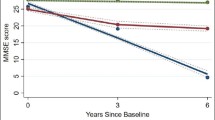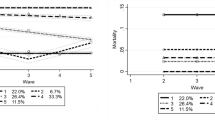Abstract
Intrinsic capacity (IC), the composite of physical and mental capacities, declines with age at different rates and patterns between individuals. We aimed to investigate the association between longitudinal IC trajectories and plasma biomarkers of two hallmarks of aging—chronic inflammation and mitochondrial dysfunction—in older adults. From the Multidomain Alzheimer Preventive Trial (MAPT), we included 1271 community-dwelling older people (mean [SD] age = 76.0 [4.3] years) with IC data over four years. Group-based multi-trajectory modeling was performed to identify clusters of the participants with similar longitudinal patterns across four IC domains: cognition, locomotion, psychology, and vitality. Five IC multi-trajectory groups were determined: low in all domains (8.4%), low locomotion (24.6%), low psychological domain (16.7%), robust (i.e., high in all domains except vitality; 28.3%), and robust with high vitality (22.0%). Compared to the best trajectory group (i.e., robust with high vitality), elevated levels of plasma interleukin-6 (IL-6), tumor necrosis factor receptor-1 (TNFR-1), and growth differentiation factor-15 (GDF-15) were associated with a higher risk of belonging to the “low in all domains” group (IL-6: relative risk ratio (RRR) [95% CI] = 1.42 [1.07 – 1.88]; TNFR-1: RRR = 1.46 [1.09 – 1.96]; GDF-15: RRR = 1.99 [1.45 – 2.73]). Higher IL-6 and GDF-15 also increased the risk of being in the “low locomotion” group. GDF-15 outperformed other biomarkers by showing the strongest associations with IC trajectory groups. Our findings found that plasma biomarkers reflecting inflammation and mitochondrial impairment distinguished older people with multi-impaired IC trajectories from those with high-stable IC.

Similar content being viewed by others
References
Beard JR, Officer A, de Carvalho IA, et al. The world report on ageing and health: a policy framework for healthy ageing. Lancet. 2016;387(10033):2145–54. https://doi.org/10.1016/S0140-6736(15)00516-4.
Cesari M, Araujo de Carvalho I, Amuthavalli Thiyagarajan J, et al. Evidence for the domains supporting the construct of intrinsic capacity. J Gerontol Ser A Biol Sci Med Sci. 2018;73(12):1653–60. https://doi.org/10.1093/gerona/gly011.
López-Ortiz S, Lista S, Peñín-Grandes S, et al. Defining and assessing intrinsic capacity in older people: A systematic review and a proposed scoring system. Ageing Res Rev. 2022;79:101640. https://doi.org/10.1016/J.ARR.2022.101640.
Tay L, Tay EL, Mah SM, Latib A, Koh C, Ng YS. Association of intrinsic capacity with frailty, physical fitness and adverse health outcomes in community-dwelling older adults. J Frailty Aging. 2022:1–9. https://doi.org/10.14283/jfa.2022.28.
Stolz E, Mayerl H, Freidl W, Roller-Wirnsberger R, Gill TM. Intrinsic capacity predicts negative health outcomes in older adults. Lipsitz LA, ed. J Gerontol - Ser A Biol Sci Med Sci. 2022;77(1):101–5. https://doi.org/10.1093/gerona/glab279.
Campbell CL, Cadar D, McMunn A, Zaninotto P. Operationalization of intrinsic capacity in older people and its association with subsequent disability, hospital admission and mortality: Results from the English longitudinal study of ageing. Magaziner J, ed. J Gerontol Ser A. 2023;78(4):698–703. https://doi.org/10.1093/gerona/glac250.
Belloni G, Cesari M. Frailty and intrinsic capacity: Two distinct but related constructs. Front Med. 2019:6. https://doi.org/10.3389/fmed.2019.00133.
Beard JR, Chen M. Intrinsic capacity as a composite outcome measure: Opportunities and challenges. J Nutr Heal Aging. 2023;27(6):398–400. https://doi.org/10.1007/s12603-023-1923-z.
World Health Organization. Integrated care for older people (ICOPE). Guidance for person-centred assessment and pathways in primary care. Geneva, Switzerland: World Health Organization. https://www.who.int/publications/i/item/WHO-FWC-ALC-19.1. Published 2019. Accessed August 19, 2022.
Bevilacqua R, Soraci L, Stara V, et al. A systematic review of multidomain and lifestyle interventions to support the intrinsic capacity of the older population. Front Med. 2022;9:2115. https://doi.org/10.3389/fmed.2022.929261.
Meng L-C, Huang S-T, Peng L-N, Chen L-K, Hsiao F-Y. Biological features of the outcome-based intrinsic capacity composite scores from a population-based cohort study: Pas de deux of biological and functional aging. Front Med. 2022;9:452. https://doi.org/10.3389/fmed.2022.851882.
Ma L, Liu P, Zhang Y, Sha G, Zhang L, Li Y. High serum tumor necrosis factor receptor 1 levels are related to risk of low intrinsic capacity in elderly adults. J Nutr Heal Aging. 2021;25(4):416–8. https://doi.org/10.1007/s12603-020-1533-y.
Ferrucci L, Fabbri E. Inflammageing: Chronic inflammation in ageing, cardiovascular disease, and frailty. Nat Rev Cardiol. 2018;15(9):505–22. https://doi.org/10.1038/s41569-018-0064-2.
Ferrucci L, Zampino M. A mitochondrial root to accelerated ageing and frailty. Nat Rev Endocrinol. 2020;16(3):133–4. https://doi.org/10.1038/s41574-020-0319-y.
Aragoni da Silva J, Rolland Y, Martinez LO, de Souto Barreto P. Mitochondrial dysfunction and intrinsic capacity: Insights from a narrative review. Le Couteur D, The Journals Gerontology Series A. 2023;78(5):735-742. doi:https://doi.org/10.1093/gerona/glac227
Andrieu S, Guyonnet S, Coley N, et al. Effect of long-term omega 3 polyunsaturated fatty acid supplementation with or without multidomain intervention on cognitive function in elderly adults with memory complaints (MAPT): A randomised, placebo-controlled trial. Lancet Neurol. 2017;16(5):377–89. https://doi.org/10.1016/S1474-4422(17)30040-6.
López-Otín C, Blasco MA, Partridge L, Serrano M, Kroemer G. Hallmarks of aging: An expanding universe. Cell. 2023;186(2):243–78. https://doi.org/10.1016/j.cell.2022.11.001.
Singh T, Newman AB. Inflammatory markers in population studies of aging. Ageing Res Rev. 2011;10(3):319–29. https://doi.org/10.1016/j.arr.2010.11.002.
Sokolova A, Hill MD, Rahimi F, Warden LA, Halliday GM, Shepherd CE. Monocyte chemoattractant protein-1 plays a dominant role in the chronic inflammation observed in Alzheimer’s disease. Brain Pathol. 2009;19(3):392–8. https://doi.org/10.1111/j.1750-3639.2008.00188.x.
Borodkina AV, Deryabin PI, Giukova AA, Nikolsky NN. “Social life” of senescent cells: What is SASP and why study it? Acta Naturae. 2018;10(1):4–14. https://doi.org/10.32607/20758251-2018-10-1-4-14.
Schafer MJ, Zhang X, Kumar A, et al. The senescence-associated secretome as an indicator of age and medical risk. JCI Insight. 2020;5(12) https://doi.org/10.1172/jci.insight.133668.
Jin HJ, Lee HJ, Heo J, et al. Senescence-associated MCP-1 secretion is dependent on a decline in BMI1 in human mesenchymal stromal cells. Antioxid Redox Signal. 2016;24(9):471–85. https://doi.org/10.1089/ars.2015.6359.
Conte M, Giuliani C, Chiariello A, Iannuzzi V, Franceschi C, Salvioli S. GDF15, an emerging key player in human aging. Ageing Res Rev. 2022;75:101569. https://doi.org/10.1016/j.arr.2022.101569.
Wang D, Day EA, Townsend LK, Djordjevic D, Jørgensen SB, Steinberg GR. GDF15: Emerging biology and therapeutic applications for obesity and cardiometabolic disease. Nat Rev Endocrinol. 2021;17(10):592–607. https://doi.org/10.1038/s41574-021-00529-7.
Gore E, Duparc T, Genoux A, Perret B, Najib S, Martinez LO. The multifaceted ATPase inhibitory factor 1 (IF1) in energy metabolism reprogramming and mitochondrial dysfunction: A new player in age-associated disorders? Antioxid Redox Signal. 2022;37(4-6):370–93. https://doi.org/10.1089/ars.2021.0137.
Folstein MF, Folstein SE, McHugh PR. “Mini-mental state”: A practical method for grading the cognitive state of patients for the clinician. J Psychiatr Res. 1975;12(3):189–98. https://doi.org/10.1016/0022-3956(75)90026-6.
Guralnik JM, Simonsick EM, Ferrucci L, et al. A short physical performance battery assessing lower extremity function: Association with self-reported disability and prediction of mortality and nursing home admission. J Gerontol. 1994;49(2):M85–94. https://doi.org/10.1093/geronj/49.2.M85.
Yesavage JA, Sheikh JI. Geriatric Depression Scale (GDS): Recent evidence and development of a shorter version. Clin Gerontol. 1986;5(1-2):165–73. https://doi.org/10.1300/J018v05n01_09.
Roberts HC, Denison HJ, Martin HJ, et al. A review of the measurement of grip strength in clinical and epidemiological studies: Towards a standardised approach. Age Ageing. 2011;40(4):423–9. https://doi.org/10.1093/ageing/afr051.
Nagin DS, Jones BL, Passos VL, Tremblay RE. Group-based multi-trajectory modeling. Stat Methods Med Res. 2018;27(7):2015–23. https://doi.org/10.1177/0962280216673085.
Giudici KV, de Souto BP, Beard J, et al. Effect of long-term omega-3 supplementation and a lifestyle multidomain intervention on intrinsic capacity among community-dwelling older adults: Secondary analysis of a randomized, placebo-controlled trial (MAPT study). Maturitas. 2020;141:39–45. https://doi.org/10.1016/j.maturitas.2020.06.012.
Locquet M, Sanchez-Rodriguez D, Bruyère O, et al. Intrinsic capacity defined using four domains and mortality risk: A 5-year follow-up of the SarcoPhAge cohort. J Nutr Heal Aging. 2022;26(1):23–9. https://doi.org/10.1007/s12603-021-1702-7.
Nagin DS, Odgers CL. Group-based trajectory modeling in clinical research. Annu Rev Clin Psychol. 2010;6:109–38. https://doi.org/10.1146/annurev.clinpsy.121208.131413.
Tavenier J, Andersen O, Nehlin JO, Petersen J. Longitudinal course of GDF15 levels before acute hospitalization and death in the general population. GeroScience. 2021;43(4):1835–49. https://doi.org/10.1007/s11357-021-00359-5.
Bautmans I, Knoop V, Amuthavalli Thiyagarajan J, et al. WHO working definition of vitality capacity for healthy longevity monitoring. Lancet Heal Longev. 2022;3(11):e789–96. https://doi.org/10.1016/S2666-7568(22)00200-8.
Ferrucci L, Penninx BWJH, Volpato S, et al. Change in muscle strength explains accelerated decline of physical function in older women with high interleukin-6 serum levels. J Am Geriatr Soc. 2002;50(12):1947–54. https://doi.org/10.1046/j.1532-5415.2002.50605.x.
Kistner TM, Pedersen BK, Lieberman DE. Interleukin 6 as an energy allocator in muscle tissue. Nat Metab. 2022;4(2):170–9. https://doi.org/10.1038/s42255-022-00538-4.
Gross AL, Walker KA, Moghekar AR, et al. Plasma markers of inflammation linked to clinical progression and decline during preclinical AD. Front Aging Neurosci. 2019:11. https://doi.org/10.3389/fnagi.2019.00229.
Buchhave P, Zetterberg H, Blennow K, Minthon L, Janciauskiene S, Hansson O. Soluble TNF receptors are associated with Aβ metabolism and conversion to dementia in subjects with mild cognitive impairment. Neurobiol Aging. 2010;31(11):1877–84. https://doi.org/10.1016/J.NEUROBIOLAGING.2008.10.012.
Conte M, Ostan R, Fabbri C, et al. Human aging and longevity are characterized by high levels of mitokines. J Gerontol - Ser A Biol Sci Med Sci. 2019;74(5):600–7. https://doi.org/10.1093/gerona/gly153.
Stowe RP, Peek MK, Cutchin MP, Goodwin JS. Plasma cytokine levels in a population-based study: Relation to age and ethnicity. Journals Gerontol - Ser A Biol Sci. Med Sci. 2010;65A:429. https://doi.org/10.1093/gerona/glp198.
Maggio M, Guralnik JM, Longo DL, Ferrucci L. Interleukin-6 in aging and chronic disease: A magnificent pathway. J Gerontol - Ser A Biol Sci Med Sci. 2006;61(6):575–84. https://doi.org/10.1093/gerona/61.6.575.
Di R, Dallmeier D, Christow H, Koenig W, Denkinger M, Klenk J. Association of growth differentiation factor 15 with other key biomarkers, functional parameters and mortality in community-dwelling older adults. Age Ageing. 2019;48(4):541–6. https://doi.org/10.1093/ageing/afz022.
Peterson MJ, Thompson DK, Pieper CF, et al. A novel analytic technique to measure associations between circulating biomarkers and physical performance across the adult life span. J Gerontol Ser A Biol Sci Med Sci. 2016;71(2):196–202. https://doi.org/10.1093/gerona/glv007.
Lee WJ, Liao YC, Wang YF, Lin IF, Wang SJ, Fuh JL. Plasma MCP-1 and cognitive decline in patients with Alzheimer’s disease and mild cognitive impairment: A two-year follow-up study. Sci Rep. 2018;8(1) https://doi.org/10.1038/s41598-018-19807-y.
Da Silva JP, Wargny M, Raffin J, et al. Plasma level of ATPase inhibitory factor 1 (IF1) is associated with type 2 diabetes risk in humans: A prospective cohort study. Diabetes Metab. 2022;49(1):101391. https://doi.org/10.1016/j.diabet.2022.101391.
Funding
The present work was performed in the context of the Inspire Program, a research platform supported by grants from the Region Occitanie/Pyrénées-Méditerranée (Reference number: 1901175) and the European Regional Development Fund (ERDF) (Project number: MP0022856). This study received funds from Alzheimer Prevention in Occitania and Catalonia (APOC Chair of Excellence - Inspire Program).
WHL has been partially supported through the grant EUR CARe N°ANR-18-EURE-0003 in the framework of the Programme des Investissements d'Avenir.
The MAPT study was supported by grants from the Gérontopôle of Toulouse, the French Ministry of Health (PHRC 2008, 2009), Pierre Fabre Research Institute (manufacturer of the omega-3 supplement), ExonHit Therapeutics SA, and Avid Radiopharmaceuticals Inc. The promotion of this study was supported by the University Hospital Center of Toulouse. The data sharing activity was supported by the Association Monegasque pour la Recherche sur la maladie d’Alzheimer (AMPA) and the INSERM-University of Toulouse III UMR 1295 Unit.
Author information
Authors and Affiliations
Contributions
WHL designed and conceptualized the research, performed the analyses, interpreted the data, and drafted the manuscript. SG interpreted the data and revised the draft critically for important intellectual content. LOM managed data of plasma IF1, interpreted the data, and revised the draft critically for important intellectual content. AL and AP managed data of plasma IL-6, TNFR-1, MCP-1, and GDF-15; interpreted the data; and revised the draft critically for important intellectual content. BV conceived the MAPT study, interpreted the data, and revised the draft critically for important intellectual content. PdSB designed and conceptualized the research, interpreted the data, and revised the draft critically for important intellectual content. All authors have read and agreed with the final version to be submitted.
Corresponding author
Ethics declarations
Competing interests
The authors declare no competing interests.
Additional information
Publisher’s note
Springer Nature remains neutral with regard to jurisdictional claims in published maps and institutional affiliations.
Supplementary information
ESM 1
(DOCX 375 kb)
About this article
Cite this article
Lu, WH., Guyonnet, S., Martinez, L.O. et al. Association between aging-related biomarkers and longitudinal trajectories of intrinsic capacity in older adults. GeroScience 45, 3409–3418 (2023). https://doi.org/10.1007/s11357-023-00906-2
Received:
Accepted:
Published:
Issue Date:
DOI: https://doi.org/10.1007/s11357-023-00906-2




